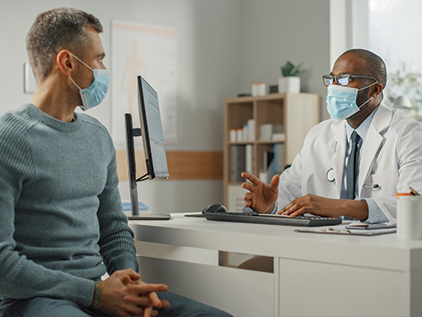- Home
- Types & Treatments
- Testicular Cancer
Testicular Cancer

Testicular cancer occurs when cells grow out of control in the testicles, or testes. The testes are the 2 male sex organs that make and store sperm, and also make the hormone testosterone. They are located in a pouch below the penis called the scrotum.
The testicular cancer specialists at The University of Kansas Cancer Center are leaders in the field. They work as a team to provide you with the latest advances in prevention, diagnosis, treatment and resources.
What is testicular cancer?
When cancer cells grow in the testicles they can spread and invade neighboring organs. They can also break away and spread to other parts of the body through the bloodstream or the lymphatic system.
Testicular cancer is rare. Most common among white males, testicular cancer is seen less often in men of African or Asian background. Young men between 15 and 35 are affected most frequently. Within this age group, testicular cancer is the most common form of cancer.
Testicular cancer can grow rapidly, but is often curable, especially when found early. When diagnosed early, the 5-year survival rate is about 95%. The stages of testicular cancer are:
- Stage 1: Cancer is found only in the testicle.
- Stage 2: Cancer has spread to the lymph nodes in the abdomen.
- Stage 3: Cancer has spread beyond the abdomen to such places as the lung and liver.
- Recurrent: Cancer has returned after treatment, either in the same place or in another part of the body.
Testicular Cancer Symptoms and Risks
Testicular cancer symptoms include:
- Swelling or a lump on your testicle, usually painless
- A dull pressure or pain in the testicle, scrotum, lower back, belly or groin
- A heavy feeling in the scrotum
- A sudden collection of fluid in the scrotum
- Any change in the size, shape or feeling of one or both testicles
The best way to detect testicular cancer symptoms is through testicular self-examination. Examine each testicle every month when you bathe or shower. Roll each testicle between your thumb and finger to feel for a lump or other change. If you find one, contact your doctor. While infection or inflammation can lead to similar testicular cancer symptoms, only your doctor can tell for sure.
In most cases, we don’t know what causes testicular cancer. Most men don’t have any known risk factors, although some problems may increase your chances. You are more likely to get testicular cancer if you:
- Have a testicle that has not dropped down into the scrotum from the belly (an undescended testicle). Normally a baby’s testicles drop down into his scrotum by the time he is 3 months old.
- Have Klinefelter syndrome. Men born with this condition have 2 or more X chromosomes. Normally, men have one X and one Y chromosome.
- Have a family history of testicular cancer.

Begin your cancer journey with a second opinion
We know the value of getting a second opinion on a cancer diagnosis. Let us help you navigate your cancer journey. Connect with one of our nurse navigators at 913-588-1227 or 844-323-1227 to schedule your cancer second opinion.
Testicular Cancer Screening and Diagnosis
Most men find testicular cancer themselves during a self-examination, or your doctor may find a lump during a routine physical exam. Symptoms of testicular cancer can be similar to other problems, so your doctor may suggest further testing if cancer is suspected.
If your doctor believes you might have testicular cancer, he or she will perform a biopsy to remove a sample of tissue. A pathologist will examine the tissue to see if there are cancer cells. If your biopsy shows cancer, your doctor will order more tests to determine if the cancer has spread to other parts of the body.
Your doctor may order blood tests to help diagnose your testicular cancer. Testicular cancer often produces protein substances called tumor markers. Measuring the levels of these markers can help your doctor diagnose you and follow your response to testicular cancer treatment.
Finally, imaging tests can help your doctor make a detailed picture of the structures inside your body:
- CT or CAT scan uses X-rays to make a detailed picture of the structures inside your body. You lie on a table while the scanner sends a series of X-ray pulses through your body. An iodine dye (contrast material) is often injected to make structures and organs easier to see on the CT pictures.
- Magnetic resonance imaging is a procedure that uses a magnet, radio waves and a computer to make detailed pictures of areas in your body. This procedure also is called nuclear magnetic resonance imaging.
- Positron emission tomography scan uses a special camera to see organs in the body. The camera records a tracer (radioactive sugar) that is put into a vein. Cancer cells use more sugar than normal cells, so the tracer shows up in the cancer cells.
- Ultrasound uses reflected sound waves to see the organs in your body. A computer analyzes the results and converts them to a picture doctors view on a monitor.
These tests help your healthcare team:
- Detect testicular cancer
- Determine the type of testicular cancer
- Learn how far it has spread (also called staging)
- Develop a testicular cancer treatment plan
Testicular Cancer Treatment
Most testicular cancer can be cured with surgery, radiation therapy and/or chemotherapy. The testicular cancer treatment your doctor chooses will depend on your age, general health and the type and stage of your cancer. Your doctor will review your medical history, blood tests, X-rays and scans to design a program that is best for you.
If your doctor recommends surgery, the entire testicle often is removed. This surgery does not make a man impotent. A man with one remaining healthy testicle can still have a normal erection, produce sperm and father children.
Sometimes lymph nodes in the abdomen also are removed. This is called a retroperitoneal lymph node dissection. Our da Vinci® Surgical System can improve the surgeons’ precision in avoiding or minimizing nerve damage. After surgery, a man can still have an erection and an orgasm, but may have some changes in the amount or form of ejaculate. Talk to your doctor about what changes to expect in sexual functioning.
After surgery, your doctor may recommend you wait and watch to see what happens. This is called watchful waiting. You’ll schedule regular checkups with your doctor to make sure the cancer is gone.
In addition to surgery, your doctor may recommend radiation and/or chemotherapy:
- Radiation therapy uses high-dose X-rays to destroy cancer cells. Radiation is usually used to treat a kind of cancer called seminoma. However, radiation therapy can sometimes be used to kill leftover cancer cells or to treat cancer that has spread beyond the testes. Radiation treatment for testicular cancer is directed at a specific area on your body. It is given on an outpatient basis, usually 5 days a week for about 3 weeks.
- Chemotherapy uses medicines to destroy cancer cells. You may receive it by injection or through your veins. Chemotherapy drugs are used to kill cancer cells that remain throughout the body after surgery for testicular cancer, and may be used before radiation.
Sometimes people with testicular cancer take part in clinical trials. Clinical research trials help find better ways of preventing, diagnosing and treating various types of cancer.
Why choose us for testicular cancer care
If you have testicular cancer, you will find the leading specialists you need at The University of Kansas Cancer Center. Our interdisciplinary team of urologic surgical oncologists, medical oncologists and radiation oncologists has years of experience treating patients with testicular cancer. Other very specialized doctors may also be involved in your care.
We offer some of the region’s most advanced cancer treatments. As a National Cancer Institute-designated comprehensive cancer center, we are committed to making a difference for patients using the latest, most advanced cancer treatments, innovative therapeutics and chemoprevention. We also apply the latest findings in cancer research to reduce side effects and improve patient outcomes.
Our team works closely with community healthcare providers throughout Kansas and the region. In many cases, you can receive your treatment near your own home in coordination with your cancer treatment team at The University of Kansas Cancer Center.
Each person is unique, so we tailor your care to your personal needs. This means doctors, nurses and other team members coordinate together to develop an individualized treatment plan. Your team will base your treatment plan on the most up-to-date information they share about your care and progress.
We take part in numerous national clinical trials on cancer treatment, as well as develop our own clinical studies to improve patient care and outcomes. Talk to your doctor to determine if a clinical trial is right for you.
Start your path today.
Your journey to health starts here. Call 913-588-1227 or request an appointment at The University of Kansas Cancer Center.